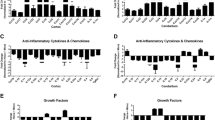Abstract
A murine model of Tay-Sachs disease, the prototype of the GM2 gangliosidoses, was produced through the targeted disruption of the Hexa gene encoding the subunit of α-hexosaminidase A. The mice were completely devoid of β-hexosaminidase A activity and accumulated GM2 ganglioside in the CNS in an age-dependent manner. Neurons with membranous cytoplasmic bodies (MCBs), identical to those described in Tay-Sachs disease, were identified in the brain of these mice. The neurons with MCBs were periodic acid-Schiff-positive on frozen sections and immunostained with anti-GM2 ganglioside antibody. However, unlike Tay-Sachs disease in which neurons throughout the brain are affected, the localization of storage neurons in these mice appeared to be limited to certain regions, i.e., cerebral cortex, the hippocampus, amygdala, hypothalamus, mammillary nucleus, etc. Storage neurons were absent in the olfactory bulb, cerebellar cortex and spinal anterior horns. The difference in the distribution of storage neurons suggests a difference of ganglioside metabolism between humans and mice. This model is useful for the study of the pathogenic mechanisms of neuronal storage in Tay-Sachs disease and for the evaluation of therapeutic strategies.
Similar content being viewed by others
References
Adachi M, Schneck L, Volk BW (1974) Ultrastructural studies of eight cases of fetal Tay-Sachs disease. Lab Invest 30: 102–112
Burg J, Banerjee A, Conzelmann E, Sandhoff K (1983) Activating proteins for ganglioside GM2 degradation by β-hexosaminidase isoenzymes in tissue extracts from different species. Hoppe-Seyler's Z Physiol Chem 364: 821–829
Carpenter MB, Sutin J (1983) Human neuroanatomy. Williams & Wilkins, Baltimore
Cork LC, Munnell JF, Lorenz MD (1977) GM2 ganglioside lysosomal storage disease in cats with β-hexosaminidase deficiency. Science 196: 1014–1017
Dobrenis K, Joseph A, Rattazzi MC (1992) Neuronal lysosomal enzyme replacement using fragment C of tetanus toxin. Proc Natl Acad Sci USA 89: 2297–2301
Goebel HH (1984) Morphology of gangliosidoses. Neuropediatrics 15 [Suppl]: 97–106
Karabelas AB, Walkley SU (1985) Altered patterns of evoked synaptic activity in cortical pyramidal neurons in feline ganglioside storage disease. Brain Res 339: 329–336
Mugnaini E, Oertel WH (1985) An atlas of the distribution of GABAergic neurons and terminals in the rat CNS as revealed by GAD immunohistochemistry. In: Bjorklund A, Hokfelt T (eds) Handbook of chemical neuroanatomy, vol 4. GABA and neuropeptides in the CNS. Elsevier, Amsterdam, pp 436–608
Muldoon LL, Neuwelt EA, Page MA, Weiss DL (1994) Characterization of the molecular defect in a feline model for type II GM2-gangliosidosis (Sandhoff disease). Am J Pathol 144: 1109–1118
Purpura DP, Suzuki K (1976) Distortion of neuronal geometry and formation of aberrant synapses in neuronal storage diseases. Brain Res 116: 1–21
Sandhoff K, Conzelmann E, Neufeld EF, Kaback MM, Suzuki K (1989) The GM2 gangliosidoses. In: Scriver CR, Beaudet AL, Sly WS, Valle D (eds) The metabolic basis of inherited disease. McGraw-Hill, New York, pp 1807–1839
Singer HS, Coyle JT, Weaver DL, Kawamura N, Baker HJ (1982) Neurotransmitter chemistry in feline GM1 gangliosidosis: a model for human ganglioside storage disease. Ann Neurol 12: 37–41
Suhr ST, Gage FH (1993) Gene therapy for neurologic disease. Arch Neurol 50: 1252–1268
Suzuki K (1991) Neuropathology of late onset gangliosidoses. A review. Dev Neurosci 13: 205–210
Walkley SU, Baker HJ, Rattazzi MC, Haskins ME, Wu JY (1991) Neuroaxonal dystrophy in neuronal storage disorders: evidence for major GABAergic neuron involvement. J Neurol Sci 104: 1–8
Yamanaka S, Johnson MD, Grinberg A, et al (1994) Targeted disruption of the Hexa gene results in mice with biochemical and pathologic features of Tay-Sachs disease. Proc Natl Acad Sci USA 91: 9975–9979
Author information
Authors and Affiliations
Rights and permissions
About this article
Cite this article
Taniike, M., Yamanaka, S., Proia, R.L. et al. Neuropathology of mice with targeted disruption of Hexa gene, a model of Tay-Sachs disease. Acta Neuropathol 89, 296–304 (1995). https://doi.org/10.1007/BF00309622
Received:
Revised:
Accepted:
Issue Date:
DOI: https://doi.org/10.1007/BF00309622




